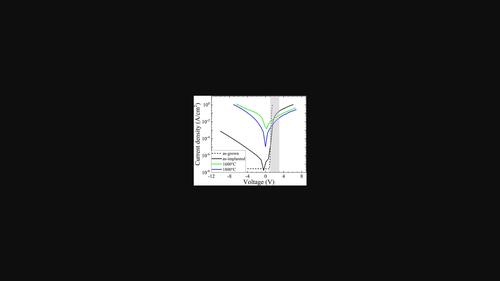当前位置:
X-MOL 学术
›
Phys. Status Solidi B
›
论文详情
Our official English website, www.x-mol.net, welcomes your
feedback! (Note: you will need to create a separate account there.)
Majority and Minority Carrier Traps in Manganese as-Implanted and Postimplantation-Annealed 4H-SiC
Physica Status Solidi (B) - Basic Solid State Physics ( IF 1.5 ) Pub Date : 2022-09-10 , DOI: 10.1002/pssb.202200210 Giovanni Alfieri 1 , Stephan Wirths 1 , Dan Buca 2 , Roberta Nipoti 3
Physica Status Solidi (B) - Basic Solid State Physics ( IF 1.5 ) Pub Date : 2022-09-10 , DOI: 10.1002/pssb.202200210 Giovanni Alfieri 1 , Stephan Wirths 1 , Dan Buca 2 , Roberta Nipoti 3
Affiliation

|
Ion implantation of amphoteric impurities, like vanadium (V) or manganese (Mn), can be employed for the formation of resistive layers in 4H-SiC. Such layers can then be used for device isolation, in order to reduce the parasitic capacitance. While V implantation can form thermally stable resistive layers, not much is known on Mn implantation. Herein, Mn ion-implanted samples are electrically characterized by means of capacitance–voltage, deep-level transient spectroscopy, and current–voltage measurements. Two ion implantation schedules are carried out: single-energy and multiple-energy ions so to have Gaussian and box-shaped Mn and related ion damage profiles, respectively—the former with a maximum concentration in the low 1016 cm−3 and the latter with a Mn plateau of 1017 cm−3. It is found that several majority carrier traps, in the 0.4–1.7 eV range below the conduction band edge, and two minority carrier traps arise after implantation and after postimplantation annealing in the 1000–1800 °C temperature range. The detected traps, as well as previous reports in the literature, show that most of them can be associated with the intrinsic defects. Box-profile implanted layers show resistivity values in the ≈106 Ω cm after heat treatments of, at least, 1600 °C.
中文翻译:

注入锰和注入后退火 4H-SiC 中的多数和少数载流子陷阱
两性杂质的离子注入,如钒 (V) 或锰 (Mn),可用于在 4H-SiC 中形成电阻层。这样的层然后可以用于器件隔离,以减少寄生电容。虽然 V 注入可以形成热稳定的电阻层,但对于 Mn 注入知之甚少。在此,Mn 离子注入样品通过电容-电压、深能级瞬态光谱和电流-电压测量进行电气表征。进行了两种离子注入计划:单能和多能离子,分别具有高斯和盒状 Mn 以及相关的离子损伤曲线——前者在低 10 16 cm -3处具有最大浓度,后者锰平台为 1017 厘米-3。发现在导带边缘以下 0.4-1.7 eV 范围内的几个多数载流子陷阱和两个少数载流子陷阱在注入后和在 1000-1800 °C 温度范围内的注入后退火后出现。检测到的陷阱以及文献中以前的报告表明,它们中的大多数都与内在缺陷有关。 在至少 1600 °C 的热处理后,箱形轮廓注入层显示出 ≈10 6 Ω cm 的电阻率值。
更新日期:2022-09-10
中文翻译:

注入锰和注入后退火 4H-SiC 中的多数和少数载流子陷阱
两性杂质的离子注入,如钒 (V) 或锰 (Mn),可用于在 4H-SiC 中形成电阻层。这样的层然后可以用于器件隔离,以减少寄生电容。虽然 V 注入可以形成热稳定的电阻层,但对于 Mn 注入知之甚少。在此,Mn 离子注入样品通过电容-电压、深能级瞬态光谱和电流-电压测量进行电气表征。进行了两种离子注入计划:单能和多能离子,分别具有高斯和盒状 Mn 以及相关的离子损伤曲线——前者在低 10 16 cm -3处具有最大浓度,后者锰平台为 1017 厘米-3。发现在导带边缘以下 0.4-1.7 eV 范围内的几个多数载流子陷阱和两个少数载流子陷阱在注入后和在 1000-1800 °C 温度范围内的注入后退火后出现。检测到的陷阱以及文献中以前的报告表明,它们中的大多数都与内在缺陷有关。 在至少 1600 °C 的热处理后,箱形轮廓注入层显示出 ≈10 6 Ω cm 的电阻率值。











































 京公网安备 11010802027423号
京公网安备 11010802027423号